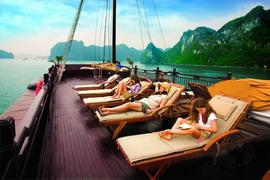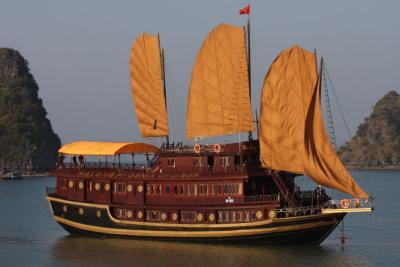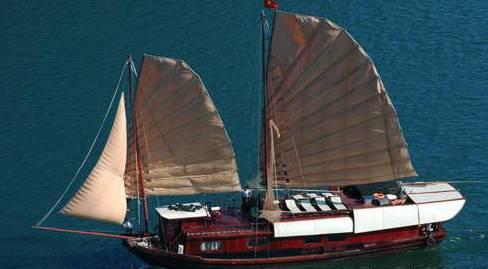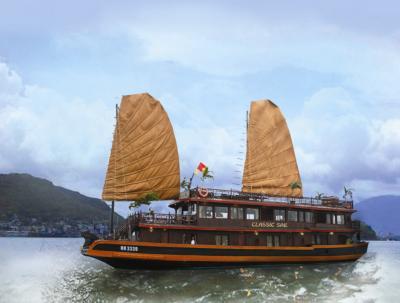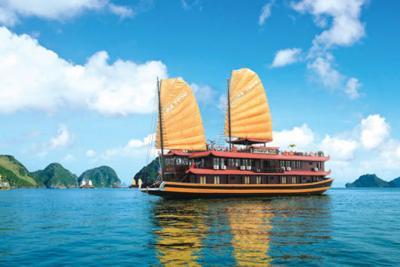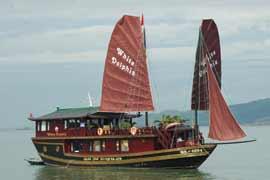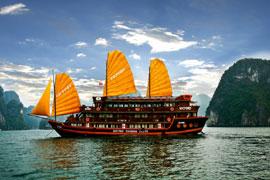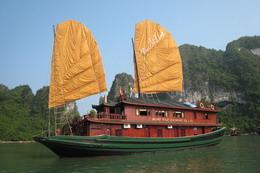Ly Son – the island of garlic
Published: 05/09/2010 05:00
| For hundreds of years, Ly Son island has been called by many as a “fairy island,” thus a destination for either businesspeople or trevellers. There are on the island well-known beauty spots such as Hang Cau (An Hai), Hang Co (An Hai), Hang To (An Vinh), Hang Ke Cuop (An Binh). There are also some others: Gieng Tien Mount, Thoi Loi Mount, Ban Than and Mu Cu isles. But the most noticeable are Hang and Duc Pagodas and An Hai Temple. Hang Pagoda, founded about 400 years ago using a natural cave, is a combination of natural feature and human labour, thus of great value in different ways: a striking evidence of the making and development of the island by Dai Viet residents. Apart from that, endowned with magnificient and poetic scenary Hang Pagoda is naturally chosen by tourists as an ideal destination for relaxation. The An Hai Village Temple in Dong Hamlet, An Hai Commune, Ly Son Island District was built in the first year of King Minh Mang (1820) in an architectural style of Nguyen Dynasty which was reflected in uniquely carved altars or on the surface of rafters, supports and doors. The temple is characterized by a worshiping combination that turns out to be the incorporation of broken pieces of Cham culture into Viet culture to make the identity of village temples on Ly Son Island: it is, on the one hand, well related to the worshiping shrine for the Vietnamese celebrities in those of An Vinh Family, Bui Ta Han Temple, Thanh Hoang Temple, Thuy Long Temple and Nghia Tu Pagoda, and is also a shrine to worship Thien Y A Na (Po Inu Nagar), Lord Ngung Man Nuong and his predecessors as well as descendants of the Cham culture on the other. Not much torn by wars, Ly Son has well stored hundreds of cultural and historical relics and diversified architecture which are densely ditributed on a narrow area. Perhaps, no other places on the mainland possess as many temples, tombs and pagodas as Ly Son does, especially those relics in connection with Hoang Sa Team set up in the reign of Nguyen Lords and Nguyen Dynasty later. There are also traces of Sa Huynh Culture (via excavations in Xom Oc, Suoi Chinh) and Cham Culture. In addition, there exist on the island the traditional boat-racing festival held yearly on 4 – 7 January of Lunar Calendar and other popular yearly events such as Khao Le The Linh Hoang Sa, An Hai Festival, Whale Worship Festival, Doi Bong Festival and others.
Source: Dan Tri/TT&VH/VOV/Quang Ngai newspaper
|
Provide by Vietnam Travel
Ly Son – the island of garlic - Travel - News | vietnam travel company
You can see more
- Travel trends in 2023
- In the spring, Moc Chau is covered in plum blossoms.
- Top 3 Special festivals in Vietnam during Tet holiday - 2023
- 5 tourist hotspots expected to see a spike in visitors during Lunar New Year 2023
- 12 Days Cycling From Vietnam to Laos
- Why You Should Cycle To Cuc Phuong National Park?
- Top 10 Must-see Sights In Hanoi, Vietnam
- The Most Wonderful Destinations In Sapa
enews & updates
Sign up to receive breaking news as well as receive other site updates!
- Banh Đa Cua - a traditional Hai Phong specialty
- Exploring Lai Chau cuisine
- Hanoi ranked top 3 cuisine in the world in 2023
- Beautiful resorts for a weekend escape close to Hanoi
- Travel trends in 2023
- In the spring, Moc Chau is covered in plum blossoms.
- The Most Wonderful Destinations In Sapa
- Top 3 Special festivals in Vietnam during Tet holiday - 2023
- 5 tourist hotspots expected to see a spike in visitors during Lunar New Year 2023
- How To Make Kitchen Cleaned
-
vietnam travel
http://www.vietnamtourism.org.vn " Vietnam Tourism: Vietnam Travel Guide, Culture, Travel, Entertainment, Guide, News, and...
-
Vietnam culture, culture travel
http://travel.org.vn " Vietnam culture
-
Vietnam travel, vietnam travel news, vietnam in photos
http://www.nccorp.vn " Vietnam travel, vietnam travel news, vietnam in photos
-
Vietnam tourism
http://www.vietnamtourism.org.vn " The official online information on culture, travel, entertainment, and including facts, maps,...
-
Vietnam Travel and Tourism
http://www.vietnamtourism.org.vn/ " Vietnam Travel, Entertainment, People, Agents, Company, Vietnam Tourism information.
-
Information travel online
http://www.travellive.org "Information travel online


















